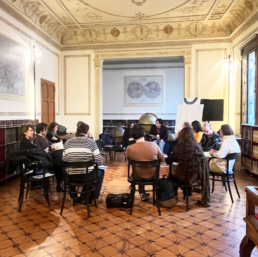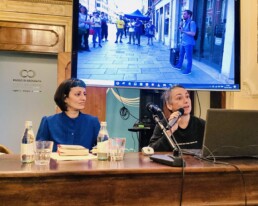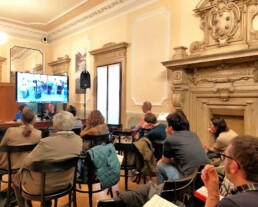Forum del Paesaggio: Progetti in movimento - 14 March 2024
Forum del Paesaggio: Progetti in movimento - 14 March 2024
Forum del Paesaggio. Progetti in movimento was organised by MoHu, DiSSGeA and the Museum of Geography, in collaboration with the Italian Ministry of Culture of Italy and the support of the City of Padua, with the aim of encouraging reflection and idea exchange among institutions, the university research and all the stakeholders operating, in various capacities, within landscape.
The event stemmed from the Department’s experience, on behalf of the Ministry of Culture, as Technical Secretariat in the latest edition (2022-23) of the Landscape Prize under the supervision of Benedetta Castiglioni, who is also Coordinator of the Master’s degree programme in Landscape Studies at the University of Padua.
On the occasion of National Landscape Day, the representatives of the 73 projects nominated for the latest edition of the Prize, along with those from past editions, and other professionals operating ‘in/with/for’ the landscape across the Italian territory, in addition to a large group of students, gathered in Padua for a unique occasion to meet and discuss relevant topics and strategies related to education, social well-being, the protection of natural and cultural heritage, and the regeneration and enhancement of territories.
The morning session, hosted by Padua Botanical Garden, started with greetings from Monica Salvadori, Vice Rector in charge of Artistic, Historical, and Cultural Heritage, Andrea Caracausi, Head of the Department of Historical and Geographic Sciences and the Ancient World (DiSSGeA), Isabella Fera from the Directorate of Archaeology, Fine Arts and Landscape (MiC) on behalf of the Director General Luigi La Rocca, Francesca Benciolini, Delegate for housing policies and residential construction at the Municipality of Padua, Salvina Sist, Director of the Territorial Planning Directorate of the Veneto Region, and Stefan Marchioro from the Tourism Directorate of the Veneto Region.
Benedetta Castiglioni introduced the speeches given by Sabrina Meneghello (University of Padua), Mauro Pascolini (University of Udine), Fulvio Adobati and Riccardo Rao (University of Bergamo), followed by the roundtable chaired by Margherita Cisani (University of Padua). The roundtable discussion involved Stefano Olivari and Matteo Baldo (Orti Generali srl Impresa sociale, winning project of the Landscape prize 2022-23 edition), Maria Grazia Bellisario (Associazione Economia della Cultura), Marco Bussone (Uncem), Paolo Castelnovi (Fondazione Landscapefor), Mario Andrea Francavilla (AIGAE), Costanza Pratesi (FAI).
The working groups, held in the afternoon at the Museum of Geography, allowed for further reflection on institutional recognitions as tools to support project development, the meeting/clash between formal aspects and practical needs, and the impact of various activities on the landscape in both material and immaterial terms, broadening the perspective towards the future.
The students of the MA in Landscape Studies were involved as facilitators of the working groups, thus experiencing in first person what public engagement means.
It was also a great opportunity to collaborate with a number of stakeholders of our Master’s degree programme.
The event was supported by the City of Padua; Veneto – The land of Venice, the Regional Landscape Observatory, and the Alumni Unipd association also joined the initiative.








PUBLIC EVENT - La città camminata - 20 March 2024
PUBLIC EVENT - La città camminata - 20 March 2024
The open seminar LA CITTÀ CAMMINATA: PRATICHE DI ATTIVISMO URBANO was organised by MoHu and the Museum of Geography to involve the students of our MA in Landscape Studies as well as the general public interested in practices of care for the city. The public seminar was co-organised with the PRIN PNRR project WALC – Walking Landscapes of Urban Cultures as part of the NaMUC – Narrative Mobilities of Urban Cultures seminar series.
The event was held to present Beatrice Barzaghi and Maria Fiano’s “Guida alla Venezia ribelle” (Voland, 2015). During the meeting, the authors shared thought-provoking reflections and narratives, drawing on Venice’s memories of rebellion and introducing the contemporary awareness-raising activities of OCIO – the civic observatory for housing issues and residentiality.
In their words, walking the city emerges as a practice of care that local activists perform to subvert the stereotypes portraying Venice only as a tourist destination while consolidating the reciprocal connections between resident communities and their urban space.
We enjoyed having Beatrice Barzaghi and Maria Fiano and deeply appreciated the ways in which they walked us through memories of rebellion to inspire our contemporary claim for an aware right to the city.


Space, Place and Mobility Student Video Contest 2024
Space, Place and Mobility Student Video Contest 2024
The 2023 edition of the videolab focussed on participatory video-making, asking our students from the MA in Mobility Studies and MA in Local Development to work in groups to provide narrative specifically focussing mobility justice. It was so amazing to watch their creative, sensitive, and empowering engagements with multiple notions of mobilities (including transport, gendered, migratory, food mobilities and many others).
This year, the Space, Place, and Mobility Student Video Contest awarded student-produced short films in two categories. THE RIDE received the ‘mobility focus’ award, while LOST IN COMMUNICATION and THREE STORIES ABOUT (NOT) MOVING AROUND received the ‘filmic quality’ award each.
This year’s ten short films and a few from prior years have been shown at the Donne.Teatro.Diritti Festival, which took place at Pacta Teatre in Milan from March 1 to April 1, 2024.


You may also check the 2023 short films out here
2024 Visiting Scholars GRANTS - CALL FOR APPLICATION (by April, 15)
2024 Visiting Scholars GRANTS - CALL FOR APPLICATION (by April, 15)
In the framework of the “Mobilities: A transdisciplinary framework for research, international teaching and public engagement in the Humanities” Department Development Project (PSD 2023-2027), the DiSSGeA (Department of Historical and Geographic Sciences and the Ancient World) has launched a 2024 Visiting Scholars GRANTS Call for Applications.
The present call is addressed to professors, researchers, and early career scholars (postdoctoral researchers, lectures, etc.) affiliated to European and non-European universities and research centres. Applicants must spend a period of approximately one (1) month at the Department and its “Mobility & Humanities” Centre for Advanced Studies from September 1st, 2024 through July 31st, 2025.
For the stay the Department will provide a total net amount of € 2.500.
The deadline for submission is April 15th, 2024 at 1:00 pm (CET).

GRANTS AWARDED
We are pleased to announce the winners of the Visiting Scholars Grants 2024, as part of the “Mobilities: A transdisciplinary framework for research, international teaching and public engagement in the Humanities” project (PSD 2023-2027).
After a thorough evaluation of the numerous applications received, the Selection Committee has identified the following scholars as recipients of the grants:
– Jensen Ole B. (Aalborg University)
– Patricia Hertel (FU Berlin / Centre Marc Bloch / University of Basel)
– Jean Sebastian “Baz” Lecocq (Humboldt University of Berlin, Institute for Asian and African Studies)
– Erik Aschenbrand (Eberswalde University for Sustainable Development)
We wish to express our sincere appreciation to all candidates for the quality and excellence of the proposals submitted. The selection was highly competitive, given the high standard of applications.
We thank everyone for their interest in our project and look forward to future opportunities for collaboration.












